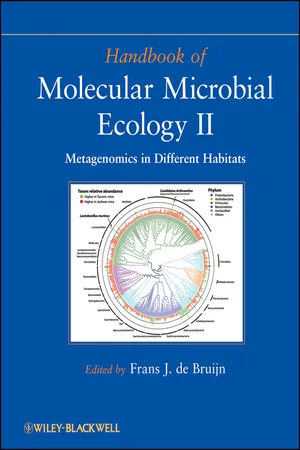Biological Sciences
Viral Genome
A viral genome refers to the complete set of genetic material (DNA or RNA) present in a virus. It contains all the information necessary for the virus to replicate and produce its proteins. Viral genomes can vary in size and structure, and they play a crucial role in the viral life cycle and interactions with host cells.
Written by Perlego with AI-assistance
Related key terms
4 Key excerpts on "Viral Genome"
- eBook - ePub
- Martinez J. Hewlett, David Camerini, David C. Bloom(Authors)
- 2021(Publication Date)
- Wiley-Blackwell(Publisher)
In essence, viruses are collections of genetic information directed toward one end: their own replication. They are the ultimate and prototypical example of “selfish genes.” The Viral Genome contains the “blueprints” for virus replication enciphered in the genetic code, and must be decoded by the molecular machinery of the cell that it infects to gain this end. Viruses are thus obligate intracellular parasites dependent on the metabolic and genetic functions of living cells.Given the essential simplicity of virus organization – a genome containing genes dedicated to self‐replication surrounded by a protective protein shell – it has been argued that viruses are nonliving collections of biochemicals whose functions are derivative and separable from the cell. Yet this generalization does not stand up to the increasingly detailed information accumulating describing the nature of viral genes, the role of viral infections in evolutionary change, and the evolution of cellular function. A view of viruses as constituting a major subdivision of the biosphere, as ancient as and fully interactive and integrated with the three great branches of cellular life, becomes more strongly established with each investigational advance.It is a major problem in the study of biology at a detailed molecular and functional level that almost no generalization is sacred, and the concept of viruses as simple parasitic collections of genes functioning to replicate themselves at the expense of the cell they attack does not hold up. Many generalizations will be made in the survey of the world of viruses introduced in this book; most if not all will be ultimately classified as being useful, but unreliable, tools for the full understanding and organization of information.Even the size range of Viral Genomes, generalized to range from one or two genes to a few hundred at most (significantly less than those contained in the simplest free‐living cells), cannot be supported by a close analysis of data. While it is true that the vast majority of viruses studied range in size from smaller than the smallest organelle to just smaller than the simplest cells capable of energy metabolism and protein synthesis, the mycoplasma and simple unicellular algae, the recently discovered mimivirus (distantly related to poxviruses such as smallpox or variola) contains nearly 1000 genes and is significantly larger than the smallest cells. With such caveats in mind, it is still appropriate to note that despite their limited size, viruses have evolved and appropriated a means of propagation and replication that ensures their survival in free‐living organisms that are generally between 10 and 10 000 000 times their size and genetic complexity. - eBook - ePub
- David P. Clark(Author)
- 2009(Publication Date)
- Academic Cell(Publisher)
Chapter Seventeen
Viruses
Viruses are Infectious Packages of Genetic Information Life Cycle of a Virus Bacterial Viruses are Known as Bacteriophage Lysogeny or Latency by Integration The Great Diversity of Viruses Small Single-Stranded DNA Viruses of Bacteria Complex Bacterial Viruses with Double Stranded DNA DNA Viruses of Higher Organisms Viruses with RNA Genomes Have Very Few Genes Bacterial RNA Viruses Double Stranded RNA Viruses of Animals Positive-Stranded RNA Viruses Make Polyproteins Strategy of Negative-Strand RNA Viruses Plant RNA Viruses Retroviruses Use both RNA and DNA Genome of the Retrovirus Subviral Infectious Agents Satellite Viruses Viroids are Naked Molecules of Infectious RNA Prions are Infectious ProteinsViruses are Infectious Packages of Genetic Information
Viruses are packages of genes inside protective shells of protein. Viruses cannot grow or divide alone. In order to replicate, a virus must first infect a host cell. Only then are the virus genes expressed and the virus components manufactured using the host cell machinery. Viruses are not merely pieces of nucleic acid like plasmids or transposons and neither are they true living cells with the ability to generate energy and make protein. They lie in the gray area between. Viruses cannot make their own proteins or generate their own energy. They can only multiply when they have entered a suitable host cell and taken over the cellular machinery. Despite this a virus is certainly not inert; it does replicate if it can subvert a host cell.Viruses are sub-cellular parasites that rely on a cell to provide energy and raw material.Virus particles contain proteins plus genetic information in the form of DNA or RNA (Fig. 17.01 ). The virus particle, or virion , consists of a protein shell, known as a capsid , surrounding a length of nucleic acid, either RNA or DNA, which carries the virus genes and is often referred to as the Viral Genome - eBook - ePub
Handbook of Molecular Microbial Ecology II
Metagenomics in Different Habitats
- Frans J. de Bruijn(Author)
- 2011(Publication Date)
- Wiley-Blackwell(Publisher)
31 on planet Earth) biological entities that likely infect and disrupt all cellular organisms (see Chapters 2, 4, and 5 in this volume). Viral metagenomics, the characterization and evaluation of viral consortia from environmental samples, has shown that viruses are unexpectedly diverse. More than 5000 viral genotypes or “species” have been detected in 100 L of seawater, and ∼1 million species have been found in 1 k of sediment [Breitbart et al., 2002, 2004; Angly et al., 2006]. Viromes collected from across the world have also shown that viral species are globally distributed (everything is everywhere) but that the relative abundance of each species is restricted by local selection (for review see Srinivasiah et al. [2008] and Vega Thurber (2009)). Lastly, viromics has shown that viral functional diversity, as well as its influence on host adaptation, has been vastly underestimated (for review see Rohwer and Vega Thurber (2009)).Some physical characteristics (e.g., capsid durability) make viruses amenable to purification. However, other aspects of their biology significantly limit viral observation, maintenance, and manipulation, including: (1) the wide range of viral particle sizes, shapes, densities, and sensitivities; (2) viral decay; and (3) variation in Viral Genome type (DNA vs. RNA and single- vs. double-stranded) and length. For example, some archaeal and eukaryotic viruses (e.g., fuselloviruses, asfraviruses, and iridoviruses) can withstand temperatures above 55°C for extended periods of time [Fauquet et al., 2005]; but depending on the prevailing abiotic and biotic conditions, some marine viral particles decay on the order of hours (∼2.5–12 h) to days [Suttle and Feng, 1992].Additionally, the majority of viruses cannot be grown in pure culture because their hosts are recalcitrant to cultivation. The lack of a single phylogenetic marker amongst viral families requires that alternative approaches to gene marker-based phylogenetics (e.g., the 16S rRNA gene sequence commonly used for Bacteria and Archaea; see Chapter 15, Vol. I) be used for the evaluation of viral consortia in environmental samples [Rohwer and Edwards, 2002]. Finally, the disparate phenetic parameters (e.g., genome type, host range, and morphological and physical characteristics, as well as genetic and genomic sequence similarities) used in viral taxonomy have generated polyphyletic viral families and obscured the evolutionary relationships between taxa and sequences [Lawrence et al., 2002]. Therefore, any researcher interested in generating and analyzing viromes must confront a suite of both methodological and analytical challenges. - eBook - ePub
Quantitative Viral Ecology
Dynamics of Viruses and Their Microbial Hosts
- Joshua Weitz(Author)
- 2016(Publication Date)
- Princeton University Press(Publisher)
These discoveries are ongoing. Indeed, in 2014 a French team of researchers reported the discovery of giant viruses related to the mimivirus family. These viruses were frozen in the Siberian tundra for more than 30,000 years, were revived, and still retained the ability to infect extant amoeba cells (Legendre et al. 2014). There is evidently more to discover on all three components of viral diversity outlined in this chapter. To understand the ecological role of viruses requires moving outward, from virus particles to virus–host interactions. That is the subject of Chapter 2. 1.3 SUMMARY • The study of virology is relatively recent. The conclusive discovery that viruses were a causative agent of infection in plants, animals, and microbes was not made until the advent of electron microscopy in the 1930s. • Viruses vary in size from genomes of a few thousand to more than a million nucleotides. • Viral capsids vary in linear dimensions from approximately 20 nm to more than 400 nm in diameter. • The elemental composition of viruses can be predicted based on simple scaling arguments. • Virus particles are relatively nutrient rich compared with their hosts. • Viral Genomes are compact, with the number of putative genes scaling linearly with genome size. • The functional diversity of viruses includes many canonical viral genes, such as those that code for capsid proteins and transcriptional regulators. • The functional diversity of viruses includes many noncanonical genes, such as those that code for proteins that are part of photosystem pathways or cell-wall pathways. 1 An old joke about physicists and spherical cows comes to mind; here it seems to apply to physiologists and spherical dogs. Nonetheless, such spheres are not a bad starting point. CHAPTER TWO Viral Life History Traits 2.1 LIFE HISTORY TRAITS IN ECOLOGY The primary aim of this chapter is to introduce a number of key commonalities and differences among viral life history traits
Learn about this page
Index pages curate the most relevant extracts from our library of academic textbooks. They’ve been created using an in-house natural language model (NLM), each adding context and meaning to key research topics.



